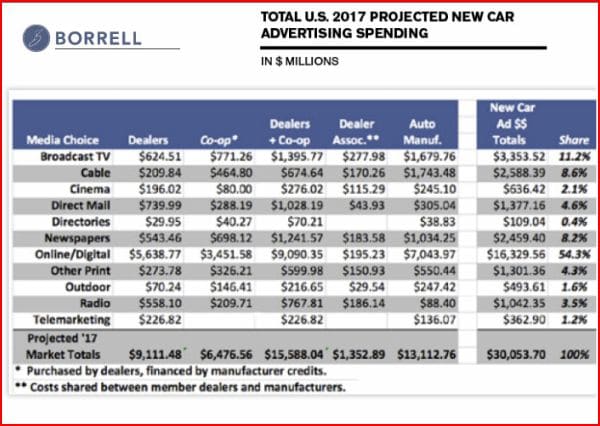
(By Mark Gorman, CEO, Matrix Solutions) Is local radio advertising worth the money? Simply put, yes. With U.S. digital advertising poised to make $83 billion in revenue this year, some advertisers are now finding it difficult to make the case for radio – especially local radio. After all, it is easier and more satisfying to see the results provided by digital advertising campaigns, using established metrics like traffic, leads, reach, click-through numbers, conversions, and other analytics. Numbers make people feel good. But with radio, the data may not be as cut-and-dry.
The value of local radio ads naturally hinges on the value that advertisers feel they are receiving from them. For example, many advertisers find value in the cost of local radio ads – they are inexpensive to produce, as the announcer often reads them (porting his/her reputation to the advertiser), and it is not necessary to create content beyond the initial script. Other benefits to local radio ads include an ability to air them quickly if a station has open advertising slots on its program log, and that they are ideally suited to a smaller, more targeted demographic that is interested in appealing to the local community.
Radio has reach. According to BIA/Kelsey’s 2016 Local Advertising Forecast, radio was among the top five media formats contributing to the local media pie, representing $15.4 billion in revenue and an 11 percent share of market. Edison Research’s The Infinite Dial 2017 reported that 82 percent of adults (18 years old or older) have listened to AM/FM radio in their car in the last month. In fact, 47 percent of these listeners report tuning in to AM/FM radio “most of the time” in their cars. And according to the Nielson Company, nearly 250 million people (12 years old and older) listen to more than 13 hours of radio each week.
Interest in local radio advertising also peaks in specific industries. Just look at the automotive industry, where local radio advertising has claimed 3.5 percent of the advertising pie.

Advertisers have seen the stats and they are increasingly turning to radio ads to help them meet their marketing goals. Even Amazon, one of the biggest names in retail, uses AM/FM radio as a consistent way to drive sales.
So, what’s the trick to proving out the worth of radio advertising? An advertiser’s ability to better track the ROI of its ad spend. Suggesting that listeners dial a different phone number upon hearing an ad, or that they type in a unique URL into their Internet browser after hearing a radio ad, are just some of the ways that advertisers can determine if the ad is directly responsible for a new customer or purchase. But these attempts will not give the full measurement of effectiveness, as these metrics are neither comprehensive nor foolproof.
The Intersection of Advertising and Promotions
According to the Radio Advertising Bureau (RAB), radio complements other types of promotions in helping brands to drive awareness and increase ROI. Unlike advertising, which is more nebulous, promotions tend to show direct KPIs – a certain number of people claiming a discount, for example. When coupled with radio advertising, promotions can pack an even bigger punch.
Event marketing at concerts, festivals, and local happenings is an increasingly common way that radio advertisers, in particular, are able to strengthen their relationship with radio listeners at local stations. And they are getting better at delivering proof-of-performance after these events – from a database of potential customers to pictures and videos to incorporate into social media posts to drive engagement.
But, too often, advertisers aren’t connecting the dots between radio advertising and the tangible results it might be able to achieve via promotions; they simply believe that the data they are looking for is not available to them. So, how can we start to show more value in local radio advertising?
In order to effectively change the way we approach local advertising, advertisers need to make a commitment to looking – really looking – at results in a different way. Beyond understanding the foundational metrics that will bring them value, like requesting a high frequency of ads, negotiating the most affordable rates, and getting their timing right, advertisers need to look at the best ways to track the success of their ads through promotions. And in so doing, they will be able to make better-informed decisions about the types of ads they run, and where, that will serve them well as they work to measure results against their established goals.
However, many advertisers are hesitant to invest heavily in finding ways to prove out the results of local radio advertising because they know if they show the effectiveness of the medium then the price of local ads may increase. Is there a way to share the pain, and the gain, more effectively? Let’s take a look at what advertisers need, versus local radio stations.
Advertisers are looking for real data to help them determine the success of their campaigns. Local radio stations are looking to prove out their value by charging competitive prices and offering up relevant ads to their listeners. The motivations of both advertisers and local radio stations are not mutually exclusive, which is why it is so important for both parties to work toward aligning their interests. For example, these parties could work together to figure out a way to tie a local radio ad placement to specific results and tie the amount paid for the ad to these results. In this way, both listeners (local radio stations) and advertisers (local businesses) would become active participants in a mutually beneficial deal where both parties have access to the information they need to successfully meet their goals.
And while the creative content of the ads themselves has a lot to do with results, it is not the only factor involved. Having some alignment in results between advertisers and local radio stations just makes sense.
On the Importance of Showing Value
As more and more media organizations look for ways to monetize, The Economist comes to mind as a print publication that is doing a nice job demonstrating the importance of alignment between advertisers and the media outlets selling ads.
Newsweek CEO Tom Ascheim has said that one of the reasons the publication remains successful, despite a $152/year cost for subscription, is that it has held firm to its pricing model since its inception. While other publications have lowered their prices in an attempt to keep circulation numbers high and charge more for advertising, The Economist has remained steadfast. It believes in the value it provides to readers, and it has chosen to bank on that in order to weather the storm that’s been brewing in the media industry for a few years now. Advertisers recognize that value and invest accordingly.
If it is possible at the national level to show value, it is certainly possible at the local level. In order to make it happen, local radio stations have to start working on packages that combine ads and promotions – making it easier for advertisers to track their success. On the other end of the spectrum, advertisers like your friendly local auto dealer need to be more open to creative sales.
In this way, advertisers and local radio stations can combine both promotions and advertising to develop a more holistic view of their relationship. Advertisers can find out more about who they are reaching by having a more comprehensive view of their budget and the deliverables they might be able to reach. Local radio stations can continue to prove out their value to both advertisers and listeners – ensuring that local radio advertising lives for years to come.
Mark Gorman brings more than 20 years of professional experience and leadership to his role as CEO at Matrix Solutions, which helps media companies to better monetize their content.







How can we apply the idea of coupling ad campaigns with advertiser promotions without encouraging advertisers to discount their products? Radio is strongest at building top of mind awareness over the long haul. It reaches the 5-10% of people in the market who are “on” for a product now, along with the other 85-90% who will be “on” for a product in the future. Digital primarily targets the 5-10% who are on right now, and therefore lacks the brand awareness ramp up delivered by broadcast media. That ramp up pays in large dividends to radio advertisers after their radio campaign has been active for 3-6 months, and even more after a full year. Radio can deliver short term results through high frequency schedules focused on a promotion, but we don’t want to train our listeners to pay attention to advertisers only when they’re having a sale. Many of our local direct advertisers are not interested in marketing to the price shopper. Perhaps a definition of “promotions” from the author would be helpful!